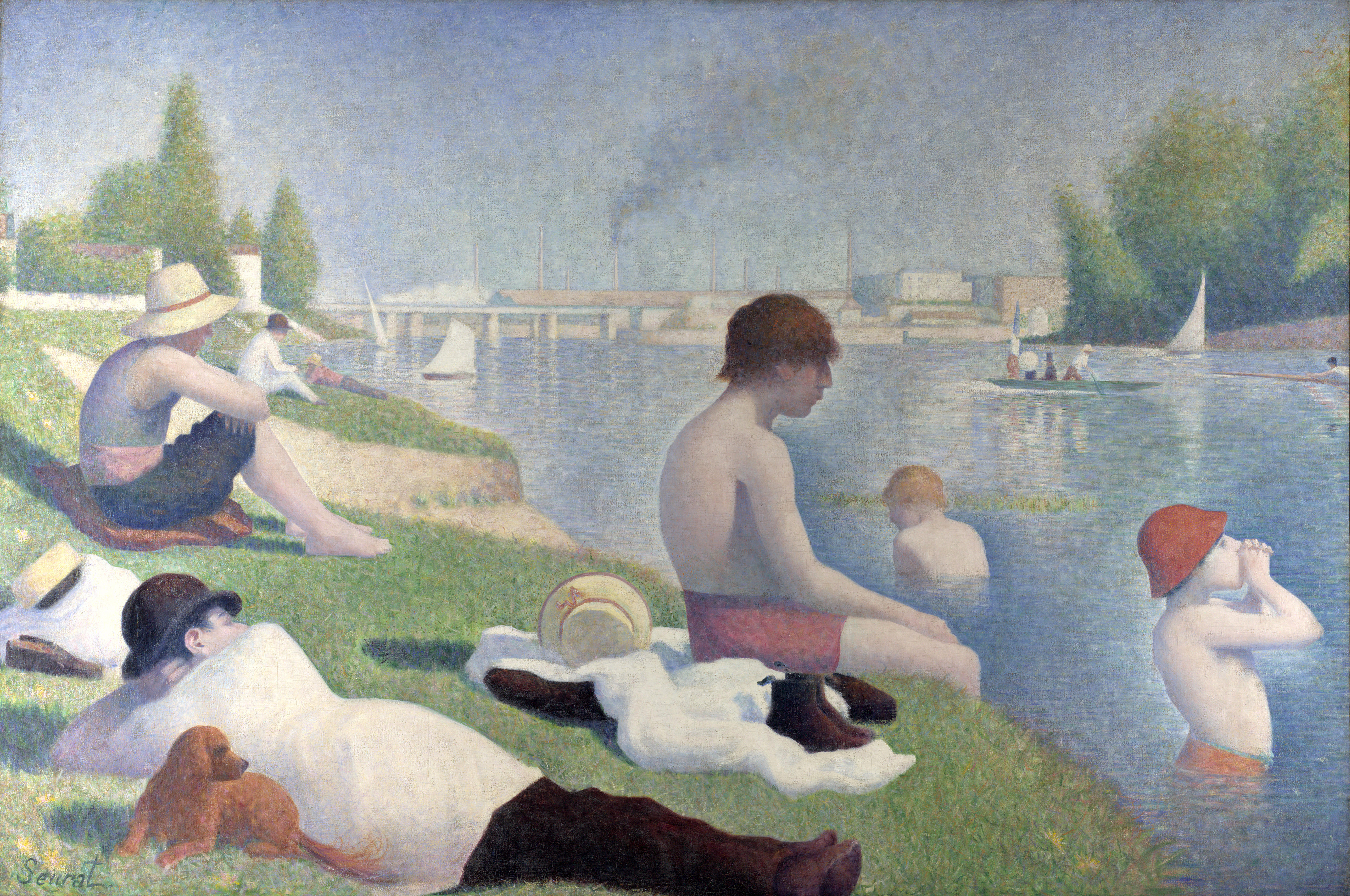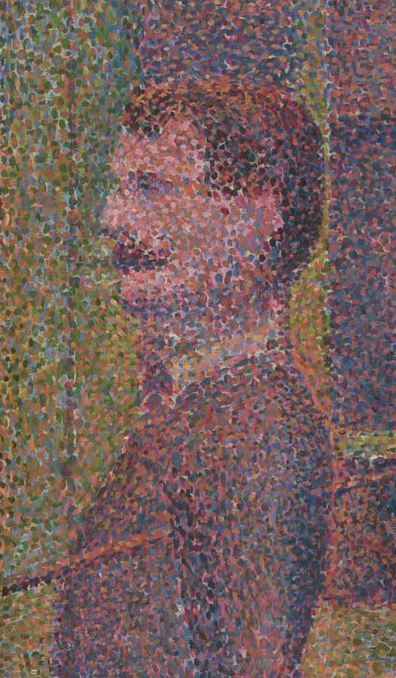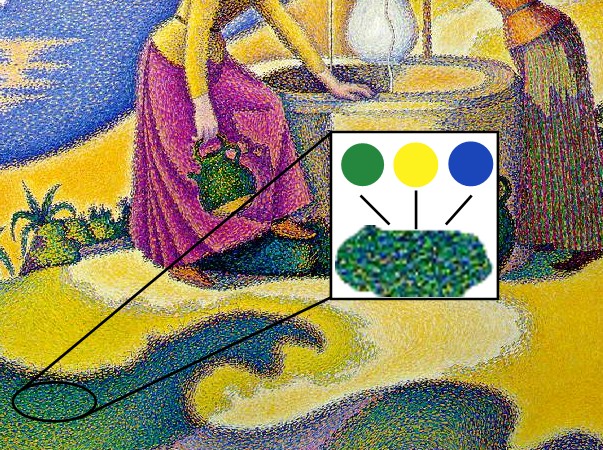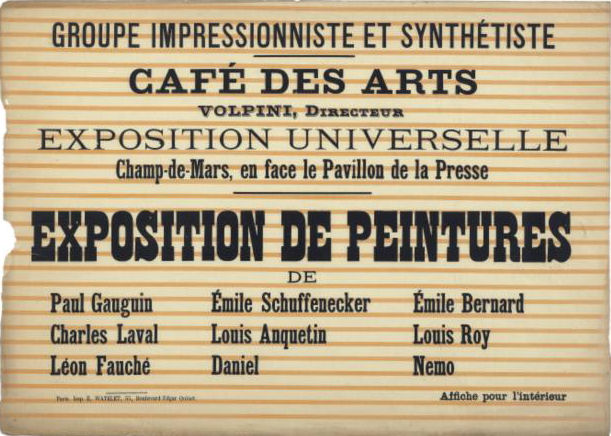|
Seurat
Georges Pierre Seurat ( , , ; 2 December 1859 – 29 March 1891) was a French post-Impressionist artist. He devised the painting techniques known as chromoluminarism and pointillism and used conté crayon for drawings on paper with a rough surface. Seurat's artistic personality combined qualities that are usually thought of as opposed and incompatible: on the one hand, his extreme and delicate sensibility, on the other, a passion for logical abstraction and an almost mathematical precision of mind. His large-scale work ''A Sunday Afternoon on the Island of La Grande Jatte'' (1884–1886) altered the direction of modern art by initiating Neo-Impressionism, and is one of the icons of late 19th-century painting. Biography Family and education Seurat was born on 2 December 1859 in Paris, at 60 rue de Bondy (now rue René Boulanger). The Seurat family moved to 136 boulevard de Magenta (now 110 boulevard de Magenta) in 1862 or 1863.Seurat: p. 16 His father, Antoine Chrysostome Seu ... [...More Info...] [...Related Items...] OR: [Wikipedia] [Google] [Baidu] |
List Of Paintings By Georges Seurat
This is a list of paintings by Georges Seurat (2 December 1859 - 29 March 1891), a Post-Impressionist/ Neo-Impressionist painter. He is noted for being the co-father of pointillism Pointillism (, ) is a technique of painting in which small, distinct dots of color are applied in patterns to form an image. Georges Seurat and Paul Signac developed the technique in 1886, branching from Impressionism. The term "Pointillism" wa .... Seurat had a short life, dying at only 31. As a result, many art historians tend not to divide his professional work into periods. References {{Reflist Paintings by Georges Seurat ... [...More Info...] [...Related Items...] OR: [Wikipedia] [Google] [Baidu] |
Bathers At Asnières
''Bathers at Asnières'' (french: Une Baignade, Asnières) is an 1884 oil on canvas painting by French artist Georges Pierre Seurat, the first of his two masterpieces on the monumental scale. The canvas is of a suburban, placid Parisian riverside scene. Isolated figures, with their clothes piled sculpturally on the riverbank, together with trees, austere boundary walls and buildings, and the River Seine are presented in a formal layout. A combination of complex brushstroke techniques and a meticulous application of contemporary color theory bring to the composition a sense of gentle vibrancy and timelessness. Seurat completed the painting of ''Bathers at Asnières'' in 1884, at 24 years old. He applied to the jury of the Salon of the same year to have the work exhibited there, only to be rejected. The ''Bathers'' continued to puzzle many of Seurat’s contemporaries, and the picture would only be widely acclaimed many years after the artist's death (age 31). An appreciation of ... [...More Info...] [...Related Items...] OR: [Wikipedia] [Google] [Baidu] |
A Sunday Afternoon On The Island Of La Grande Jatte
''A Sunday Afternoon on the Island of La Grande Jatte'' (french: Un dimanche après-midi à l'Île de la Grande Jatte) was painted from 1884 to 1886 and is Georges Seurat's most famous work. A leading example of pointillist technique, executed on a large canvas, it is a founding work of the neo-impressionist movement. Seurat's composition includes a number of Parisians at a park on the banks of the River Seine. It is in the collection of the Art Institute of Chicago. Background In 1879, Georges Seurat enlisted as a soldier in the French army and arrived back home in 1880. Later, he ran a small painter's studio in Paris, and in 1883 showed his work publicly for the first time. The following year, Seurat began to work on ''La Grande Jatte'' and exhibited the painting in the spring of 1886 with the Impressionists. With ''La Grande Jatte'', Seurat was immediately acknowledged as the leader of a new and rebellious form of Impressionism called Neo-Impressionism. Seurat painted '' ... [...More Info...] [...Related Items...] OR: [Wikipedia] [Google] [Baidu] |
Neo-Impressionism
Neo-Impressionism is a term coined by French art critic Félix Fénéon in 1886 to describe an art movement founded by Georges Seurat. Seurat's most renowned masterpiece, '' A Sunday Afternoon on the Island of La Grande Jatte'', marked the beginning of this movement when it first made its appearance at an exhibition of the Société des Artistes Indépendants (Salon des Indépendants) in Paris. Around this time, the peak of France's modern era emerged and many painters were in search of new methods. Followers of Neo-Impressionism, in particular, were drawn to modern urban scenes as well as landscapes and seashores. Science-based interpretation of lines and colors influenced Neo-Impressionists' characterization of their own contemporary art. The Pointillist and Divisionist techniques are often mentioned in this context, because they were the dominant techniques in the beginning of the Neo-impressionist movement. Some argue that Neo-Impressionism became the first true avant-gar ... [...More Info...] [...Related Items...] OR: [Wikipedia] [Google] [Baidu] |
Divisionism
Divisionism, also called chromoluminarism, was the characteristic style in Neo-Impressionist painting defined by the separation of colors into individual dots or patches which interacted optically..Homer, William I. ''Seurat and the Science of Painting.'' Cambridge, MA: The MIT Press, 1964. By requiring the viewer to combine the colors optically instead of physically mixing pigments, Divisionists believed they were achieving the maximum luminosity scientifically possible. Georges Seurat founded the style around 1884 as chromoluminarism, drawing from his understanding of the scientific theories of Michel Eugène Chevreul, Ogden Rood and Charles Blanc, among others. Divisionism developed along with another style, Pointillism, which is defined specifically by the use of dots of paint and does not necessarily focus on the separation of colors.Ratliff, Floyd. ''Paul Signac and Color in Neo-Impressionism.'' New York: Rockefeller UP, 1992. . Theoretical foundations and development ... [...More Info...] [...Related Items...] OR: [Wikipedia] [Google] [Baidu] |
Pointillism
Pointillism (, ) is a technique of painting in which small, distinct dots of color are applied in patterns to form an image. Georges Seurat and Paul Signac developed the technique in 1886, branching from Impressionism. The term "Pointillism" was coined by art critics in the late 1880s to ridicule the works of these artists, but is now used without its earlier pejorative connotation. The movement Seurat began with this technique is known as Neo-impressionism. The Divisionists used a similar technique of patterns to form images, though with larger cube-like brushstrokes. Technique The technique relies on the ability of the eye and mind of the viewer to blend the color spots into a fuller range of tones. It is related to Divisionism, a more technical variant of the method. Divisionism is concerned with color theory, whereas pointillism is more focused on the specific style of brushwork used to apply the paint. It is a technique with few serious practitioners today and is notably ... [...More Info...] [...Related Items...] OR: [Wikipedia] [Google] [Baidu] |
Pointillism
Pointillism (, ) is a technique of painting in which small, distinct dots of color are applied in patterns to form an image. Georges Seurat and Paul Signac developed the technique in 1886, branching from Impressionism. The term "Pointillism" was coined by art critics in the late 1880s to ridicule the works of these artists, but is now used without its earlier pejorative connotation. The movement Seurat began with this technique is known as Neo-impressionism. The Divisionists used a similar technique of patterns to form images, though with larger cube-like brushstrokes. Technique The technique relies on the ability of the eye and mind of the viewer to blend the color spots into a fuller range of tones. It is related to Divisionism, a more technical variant of the method. Divisionism is concerned with color theory, whereas pointillism is more focused on the specific style of brushwork used to apply the paint. It is a technique with few serious practitioners today and is notably ... [...More Info...] [...Related Items...] OR: [Wikipedia] [Google] [Baidu] |
Post-Impressionism
Post-Impressionism (also spelled Postimpressionism) was a predominantly French art movement that developed roughly between 1886 and 1905, from the last Impressionist exhibition to the birth of Fauvism. Post-Impressionism emerged as a reaction against Impressionists' concern for the naturalistic depiction of light and colour. Its broad emphasis on abstract qualities or symbolic content means Post-Impressionism encompasses Les Nabis, Neo-Impressionism, Symbolism, Cloisonnism, the Pont-Aven School, and Synthetism, along with some later Impressionists' work. The movement's principal artists were Paul Cézanne (known as the father of Post-Impressionism), Paul Gauguin, Vincent van Gogh and Georges Seurat. The term Post-Impressionism was first used by art critic Roger Fry in 1906.Peter Morrin, Judith Zilczer, William C. Agee, ''The Advent of Modernism. Post-Impressionism and North American Art, 1900-1918'', High Museum of Art, 1986 Critic Frank Rutter in a review of the Salon ... [...More Info...] [...Related Items...] OR: [Wikipedia] [Google] [Baidu] |
Paul Signac
Paul Victor Jules Signac ( , ; 11 November 1863 – 15 August 1935) was a French Neo-Impressionist painter who, working with Georges Seurat, helped develop the Pointillist style. Biography Paul Signac was born in Paris on 11 November 1863. He followed a course of training in architecture before, at the age of 18, deciding to pursue a career as a painter, after attending an exhibit of Monet's work. He sailed on the Mediterranean Sea, visiting the coasts of Europe and painting the landscapes he encountered. In later years, he also painted a series of watercolors of French harbor cities. In 1884 he met Claude Monet and Georges Seurat. He was struck by the systematic working methods of Seurat and by his theory of colors and he became Seurat's faithful supporter, friend, and heir with his description of Neo-Impressionism and Divisionism method. Under Seurat's influence he abandoned the short brushstrokes of Impressionism to experiment with scientifically-juxtaposed small d ... [...More Info...] [...Related Items...] OR: [Wikipedia] [Google] [Baidu] |
Post-Impressionist
Post-Impressionism (also spelled Postimpressionism) was a predominantly French art movement that developed roughly between 1886 and 1905, from the last Impressionist exhibition to the birth of Fauvism. Post-Impressionism emerged as a reaction against Impressionists' concern for the naturalistic depiction of light and colour. Its broad emphasis on abstract qualities or symbolic content means Post-Impressionism encompasses Les Nabis, Neo-Impressionism, Symbolism, Cloisonnism, the Pont-Aven School, and Synthetism, along with some later Impressionists' work. The movement's principal artists were Paul Cézanne (known as the father of Post-Impressionism), Paul Gauguin, Vincent van Gogh and Georges Seurat. The term Post-Impressionism was first used by art critic Roger Fry in 1906.Peter Morrin, Judith Zilczer, William C. Agee, ''The Advent of Modernism. Post-Impressionism and North American Art, 1900-1918'', High Museum of Art, 1986 Critic Frank Rutter in a review of the Salon d'Autom ... [...More Info...] [...Related Items...] OR: [Wikipedia] [Google] [Baidu] |
Société Des Artistes Indépendants
The Société des Artistes Indépendants (''Society of Independent Artists'') or Salon des Indépendants was formed in Paris on 29 July 1884. The association began with the organization of massive exhibitions in Paris, choosing the slogan "''sans jury ni récompense''" ("without jury nor reward"). Albert Dubois-Pillet, Odilon Redon, Georges Seurat and Paul Signac were among its founders. For the following three decades their annual exhibitions set the trends in art of the early 20th century, along with the Salon d'Automne. This is where artworks were often first displayed and widely discussed. World War I brought a closure to the salon, though the ''Artistes Indépendants'' remained active. Since 1920, the headquarters has been located in the vast basements of the Grand Palais (next door to the ''Société des Artistes Français'', the '' Société Nationale des Beaux-Arts'', the Société du Salon d'Automne, and others). History The Salon des Indépendants (Salon des Artistes ... [...More Info...] [...Related Items...] OR: [Wikipedia] [Google] [Baidu] |
Charles Angrand
Charles Angrand (19 April 1854 – 1 April 1926) was a French artist who gained renown for his Neo-Impressionist paintings and drawings. He was an important member of the Parisian avant-garde art scene in the late 1880s and early 1890s. Early life and work Charles Théophile Angrand was born in Criquetot-sur-Ouville, Normandy, France, to schoolmaster Charles P. Angrand (1829–96) and his wife Marie (1833–1905). He received artistic training in Rouen at Académie de Peinture et de Dessin. His first visit to Paris was in 1875, to see a retrospective of the work of Jean-Baptiste-Camille Corot at École des Beaux-Arts. Corot was an influence on Angrand's early work. After being denied entry into École des Beaux-Arts, he moved to Paris in 1882, where he began teaching mathematics at Collège Chaptal. His living quarters were near Café d'Athènes, Café Guerbois, Le Chat Noir, and other establishments frequented by artists. Angrand joined the artistic world of the Parisian avan ... [...More Info...] [...Related Items...] OR: [Wikipedia] [Google] [Baidu] |

.jpg)







